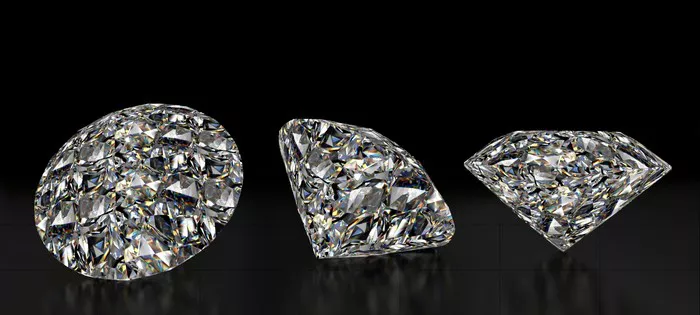Gemstones have captivated humanity for millennia with their mesmerizing beauty, rarity, and cultural significance. Among the plethora of gemstones that adorn our world, a select few stand out as the most precious, coveted for their exceptional qualities and allure. In this exploration, we delve into the realm of luxury and sophistication to uncover the three most precious stones that have fascinated civilizations across the ages.
1. Diamond: The Reigning King of Gemstones
Diamonds have long held the title of the most coveted gemstone, renowned for their unparalleled brilliance, hardness, and timeless elegance. Formed deep within the Earth’s mantle under intense pressure and heat, diamonds emerge as nature’s exquisite masterpiece, captivating the eye with their dazzling sparkle.
One of the most remarkable aspects of diamonds is their exceptional hardness, ranking as a perfect 10 on the Mohs scale. This hardness, coupled with their remarkable clarity and colorlessness, makes diamonds not only stunningly beautiful but also incredibly durable, suitable for enduring the test of time.
Beyond their physical attributes, diamonds carry profound symbolic significance, representing enduring love, strength, and purity. These qualities have made diamonds the ultimate choice for engagement rings, symbolizing the eternal commitment between two individuals.
Moreover, diamonds have played pivotal roles in history, culture, and commerce. From the legendary Koh-i-Noor diamond, steeped in centuries of myth and intrigue, to iconic diamonds adorning the crowns of monarchs and the jewelry collections of elites, these gemstones have left an indelible mark on human civilization.
2. Ruby: The Gemstone of Passion and Power
Ruby, with its fiery red hue, exudes a sense of passion, vitality, and power. As one of the traditional cardinal gems, along with sapphire, emerald, and diamond, rubies have enchanted cultures across the globe with their rich color and inherent mystique.
The allure of rubies lies not only in their vibrant hue but also in their rarity and exceptional hardness, second only to diamonds among natural gemstones. Originating from the mineral corundum, rubies derive their red color from traces of chromium within the crystal structure, imbuing them with a mesmerizing glow that commands attention.
Throughout history, rubies have been associated with royalty, nobility, and prosperity. In ancient civilizations, rubies were believed to possess protective powers, warding off evil and ensuring health, wealth, and success to their wearers. This belief endured through the ages, with rubies adorning the crowns, jewelry, and ceremonial regalia of monarchs and aristocrats.
Beyond their historical significance, rubies continue to captivate the modern world with their timeless allure. From exquisite ruby necklaces and earrings to dazzling engagement rings, these gemstones serve as symbols of passion, romance, and enduring love, cherished by connoisseurs and collectors alike.
3. Emerald: The Gemstone of Enchantment and Renewal
Emeralds, with their lush green hue reminiscent of springtime foliage, evoke a sense of freshness, vitality, and natural beauty. Revered by ancient civilizations as symbols of rebirth and renewal, emeralds have enchanted humanity for thousands of years with their captivating color and mystical allure.
Emeralds belong to the beryl family of gemstones, renowned for their intense green coloration caused by trace amounts of chromium, vanadium, or iron within the crystal lattice. The finest emeralds exhibit a rich, velvety green hue, often described as “emerald green,” which is highly prized by collectors and enthusiasts.
In addition to their captivating color, emeralds possess a unique character characterized by their inherent flaws and inclusions, known as “jardin,” which add to their individuality and charm. While these inclusions may affect clarity, they also serve as hallmarks of authenticity, distinguishing natural emeralds from synthetic imitations.
Throughout history, emeralds have been revered by cultures around the world for their mystical properties and symbolic significance. In ancient lore, emeralds were believed to confer wisdom, foresight, and protection against enchantment, making them prized talismans for kings, queens, and spiritual leaders.
Today, emeralds continue to captivate the imagination with their timeless beauty and allure. From exquisite emerald necklaces and bracelets to statement earrings and engagement rings, these gemstones serve as symbols of vitality, growth, and harmony, embodying the eternal cycle of nature and the promise of new beginnings.
In conclusion, diamonds, rubies, and emeralds stand out as the three most precious stones in the world, each possessing unique qualities and allure that have captivated humanity for centuries. Whether admired for their brilliance, color, or symbolism, these gemstones embody the pinnacle of luxury, sophistication, and timeless elegance, enchanting generations with their enduring beauty and mystique.
FAQs
Are diamonds, rubies, and emeralds suitable for everyday wear?
While diamonds are incredibly durable and suitable for everyday wear, rubies and emeralds require more care due to their slightly lower hardness on the Mohs scale. It’s advisable to avoid exposing rubies and emeralds to harsh chemicals and extreme temperatures to preserve their beauty and integrity.
Are there synthetic or lab-grown alternatives to diamonds, rubies, and emeralds?
Yes, synthetic or lab-grown diamonds, rubies, and emeralds are available as alternatives to their natural counterparts. These lab-grown gemstones possess the same chemical and physical properties as natural stones but are created in controlled laboratory environments. While synthetic gemstones offer affordability and ethical considerations, natural gemstones often carry greater value and prestige due to their rarity and uniqueness.
What are some famous examples of diamonds, rubies, and emeralds in history?
Examples of famous diamonds include the Koh-i-Noor, the Hope Diamond, and the Cullinan Diamond. Rubies such as the Sunrise Ruby and the Mogok Ruby have achieved legendary status, while emeralds like the Emerald of Saint Louis and the Duke of Devonshire Emerald showcase the allure of these gemstones throughout history.
Do diamonds, rubies, and emeralds have any cultural or symbolic significance?
Yes, diamonds symbolize enduring love, strength, and purity, making them popular choices for engagement rings. Rubies are associated with passion, power, and prosperity, while emeralds symbolize renewal, growth, and harmony. Throughout history, these gemstones have been revered by various cultures for their mystical properties and symbolic meanings.

